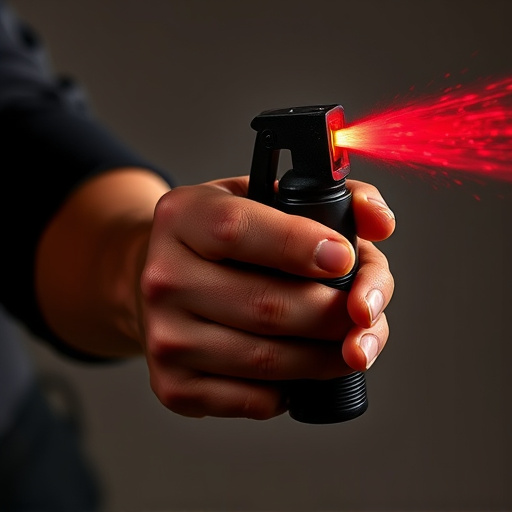OC spray, an effective non-lethal self-defense tool, uses capsaicin (derived from chili peppers) as its primary active ingredient at concentration levels typically between 1% to 2%. This irritant temporarily disorients attackers by targeting their eyes, nose, and respiratory system. Proper delivery systems maximize impact while minimizing harm to bystanders. Understanding capsaicin concentration levels is crucial for evaluating deterrence effectiveness; higher concentrations offer stronger protection but should be balanced with individual needs and threat scenarios. Regular training is essential for optimal use in high-stress situations.
“Unveiling the power of OC spray as a personal defense mechanism, this article delves into the science behind its deterrence. We explore how capsaicin, the active ingredient, disrupts sensory perception and provides a non-lethal means of self-defense. Understanding concentration levels is key; different strengths offer varying levels of protection.
From the chemistry of capsaicin to practical application, read on to learn how OC spray can empower individuals in potentially dangerous situations, focusing on its effectiveness as a personal safety tool.”
- Understanding OC Spray: An Overview of Capsaicin
- The Science Behind Pepper Spray's Deterrent Effectiveness
- Deciphering Concentration Levels: What Matters and Why
- Implementing and Using Pepper Spray for Personal Defense
Understanding OC Spray: An Overview of Capsaicin
OC spray, or Oleoresin Capsaicin spray, is a non-lethal self-defense tool designed to incapacitate an attacker temporarily. The active ingredient in OC spray is capsaicin, a chemical derived from chili peppers. Capsaicin is known for its burning sensation when it comes into contact with mucous membranes, making it an effective deterrent.
The concentration levels of capsaicin in OC spray vary, typically ranging from 1% to 2%. This concentration is enough to cause irritation and discomfort, disorienting the assailant and providing the user with time to escape or seek help. The effectiveness of OC spray lies not only in its capsaicin content but also in its delivery system, which ensures a precise and controlled release of the chemical, maximizing its impact while minimizing harm to bystanders.
The Science Behind Pepper Spray's Deterrent Effectiveness
The effectiveness of pepper spray as a deterrent lies in its active ingredient, capsaicin—a chemical found in chili peppers. When deployed, OC (Oleoresin Capsaicin) spray creates a potent irritant that directly targets the eyes, nose, and respiratory system. The capsaicin concentration levels vary in different types of pepper spray, but even low concentrations can cause temporary blindness, severe coughing, and difficulty breathing. This immediate physical discomfort acts as a powerful psychological deterrent, often causing potential aggressors to retreat.
The science behind its deterrent effectiveness is multifaceted. First, the intense heat sensation induced by capsaicin overrides normal sensory perception, disrupting an individual’s ability to think clearly. Second, it triggers a reflex response, prompting the body to protect itself from the irritant. This combination of physical and psychological effects makes pepper spray a reliable defense mechanism, especially in self-defense scenarios where every second counts.
Deciphering Concentration Levels: What Matters and Why
Understanding OC spray’s capsaicin concentration levels is paramount in evaluating its effectiveness as a deterrent. Different formulations and brand variations exist, each boasting specific percentages. However, what truly matters is not just the presence of capsaicin but its potency. Higher concentrations mean stronger irritancy, ensuring potential assailants are deterred more effectively. This is why manufacturers often provide detailed information on their products’ active ingredients and concentration ratios—it’s a key factor in personal safety.
When considering OC spray as a defense mechanism, knowing the capsaicin levels allows users to make informed choices. A higher concentration doesn’t automatically guarantee better protection; it should be balanced with an individual’s specific needs and potential threat scenarios. Thus, understanding these levels is crucial for anyone looking to enhance their personal safety arsenal.
Implementing and Using Pepper Spray for Personal Defense
Implementing and using pepper spray for personal defense has become a popular choice for individuals seeking effective self-protection. Known as OC spray, it contains capsaicin, the active ingredient derived from chili peppers, which irritates the eyes, nose, and respiratory system when inhaled. The capsaicin in OC spray is available in various concentration levels, typically ranging from 1% to 2%, ensuring a powerful yet controllable effect.
When deployed correctly, pepper spray can provide a crucial defense mechanism against potential assailants. Users should aim for the face, specifically the eyes and nose, as these areas are highly sensitive to capsaicin. It’s essential to remember that OC spray is designed to disable an attacker temporarily, allowing the user to escape or seek help. Regular training and familiarization with the spray’s functionality are vital to ensure its effectiveness in high-stress situations.
OC Spray, a powerful defense mechanism, harnesses the natural compound capsaicin to deter potential threats. The science behind its effectiveness is clear, with specific concentration levels playing a crucial role in its success as a personal defense tool. By understanding capsaicin’s impact and implementing proper usage techniques, individuals can empower themselves with this effective deterrent, ensuring their safety in various situations.
